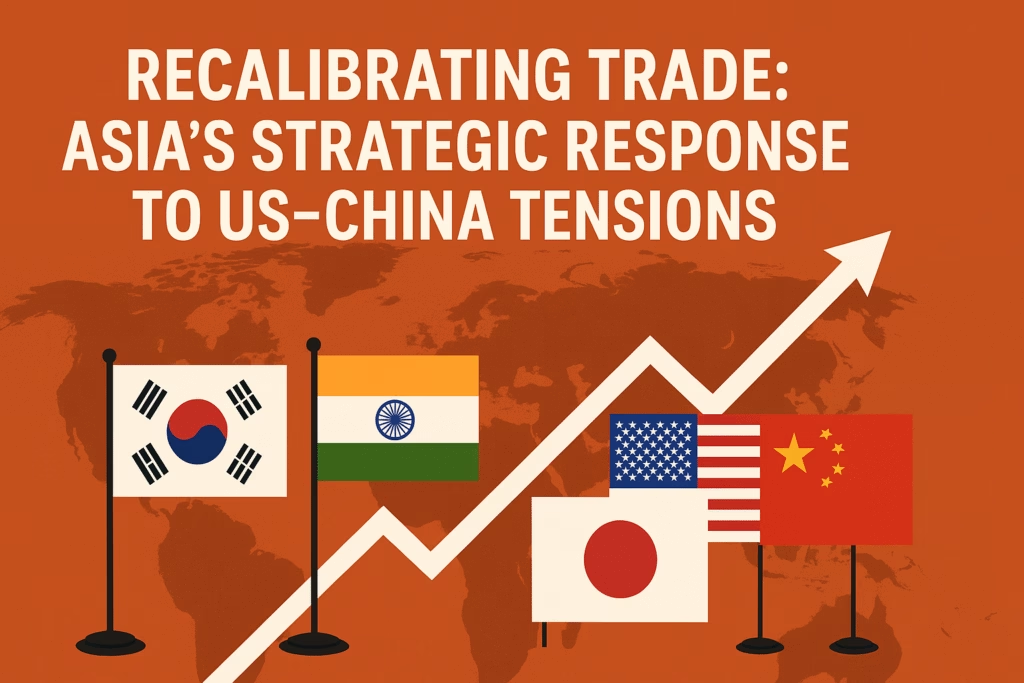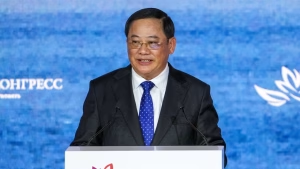The US–China trade dispute – marked by tariffs on hundreds of billions of dollars of goods, technology restrictions, and strategic decoupling – has sent shockwaves through global supply chains. Asian economies tightly linked to both powers are feeling the impact. In response, countries like South Korea, Japan and India are recalibrating their trade strategies: diversifying markets, strengthening key industries, and forging new partnerships. Meanwhile, China is also adjusting its approach. The sections below examine recent data and developments illustrating these shifts.
South Korea: The Frontline of Diversification
South Korea has historically been highly dependent on China. Since China’s WTO accession in 2001, China has been South Korea’s #1 trading partner, accounting for roughly a quarter of its trade (piie.com). In 2023, this changed dramatically. Seoul’s exports to China plummeted 19.9% from the previous year(piie.com). By contrast, exports to the United States surged: the U.S. share of Korean exports hit 18.3% (a 20-year high) as the gap between the U.S. and China export shares narrowed to just 1.4 percentage points (piie.com). In December 2023, Korean shipments to the U.S. ($11.3 billion) even exceeded those to China ($10.9 billion) for the first time in two decades (piie.com). On an annual basis, Seoul posted its first trade deficit with China ($18 billion) since 1992, alongside a record surplus with the U.S. ($45 billion) (piie.com).
- Market realignment: South Korea’s rapid export shift highlights its strategic hedging. Chinese demand has cooled (due to China’s economic slowdown and domestic “self-reliance” push (piie.com), while robust demand in the U.S. and other markets has picked up the slack.
- Industrial policy support: To fortify its competitiveness, Seoul has increased subsidies for key sectors. In April 2025, the government raised its semiconductor support package to 33 trillion won (~$23B) – a roughly 25% boost – explicitly citing “U.S. policy uncertainty and rising competition from Chinese rivals” as the reason (reuters.com). Similarly, emergency measures for the auto industry were announced to offset U.S. tariffs, including financial aid, tax cuts, and efforts to expand overseas markets (reuters.com).
- Trade diplomacy: Korea is also engaging in new trade talks. It has modernised its U.S. FTA and is pursuing membership in the CPTPP regional pact. Seoul continues to seek stronger ties within Asia (e.g. reaffirming RCEP commitments) and with the European Union to diversify its export destinations.
Together, these adjustments underscore how Korea – a highly open, export-driven economy – is frontally diversifying away from China-dependence and bolstering domestic capabilities in response to the US–China standoff (piie.com, reuters.com).
Japan: Strategic Diversification in Motion
Japan has likewise been reacting to trade-war headwinds by broadening its options. China is Japan’s largest trading partner, but in late 2022, Japanese exports to China began to stagnate or fall, while shipments to the U.S. grew. For example, in December 2022, exports to China fell 6.2% year-on-year, whereas exports to the U.S. rose 16.9% (reuters.com). Weak Chinese demand (for cars and machinery) combined with a stronger yen has weighed on Japanese exports. Policymakers warned that continued softness in China could dampen Japan’s factory output and growth (Reuters.com).
- Export trends: Recent trade data highlight Japan’s shifting flows. Though still early, China-bound exports are sagging while U.S.– and regional-bound exports hold up better (reuters.com). (Japan’s auto and high-tech industries have begun expanding production in Southeast Asia and the U.S. to hedge against Chinese slowdowns.)
- Trade negotiations: Tokyo has stepped up negotiations with the U.S. In April 2025, Reuters reported that the United States and Japan were moving toward an interim trade agreement outline (reuters.com). This framework is likely to ease some tariffs and address non-tariff barriers, though thorny issues (like auto tariffs and digital rules) may be deferred. Closer Japan–U.S. talks signal a strategic tilt toward harmonising trade policies with the American market (reuters.com).
- Regional initiatives: Japan is also leveraging multilateral pacts. It is a key participant in RCEP (which includes China and ASEAN) and the CPTPP, seeking to deepen regional supply chains. Bilaterally, Japan is strengthening ties with the EU (digital trade talks) and committing to Indo-Pacific economic forums (like IPEF) to promote supply-chain resilience. Domestically, Japan’s government and business groups are pushing higher-value manufacturing (semiconductors, green tech, pharmaceuticals) to compete globally.
In sum, Japan is spreading its wings: adjusting export markets and production sites, while using diplomatic channels (e.g. trade talks and FTAS) to anchor growth beyond China.
India: Pursuing New Partnerships and Self-Reliance
India’s trade calculus is shifting as well. China has long been a top partner (about 10% of India’s trade)(weforum.org), but the bilateral trade balance is sharply lopsided. In FY2024/25 (ending March 2025), India’s trade deficit with China hit a record $99.2 billion (reuters.com). This was driven by surging imports of electronics, batteries and solar products: e.g. in March 2025 alone, China imports jumped +25% YoY to $9.7 billion (reuters.com). By contrast, India’s exports to China fell by 14.5% in that period (Reuters.com). Observers call this a “wake-up call,” highlighting India’s heavy dependence on Chinese components (reuters.com).
- Trade imbalance: The scale of the deficit underscores India’s vulnerability. Despite global supply-chain diversification efforts, China remains the main source of critical inputs for India’s booming industries. These imbalances have prompted New Delhi to push for import substitution (e.g. boosting domestic chip, battery and pharmaceutical manufacturing) under its “Make in India” and production-linked incentive programs.
- New trade partnerships: India is aggressively seeking alternate markets. Trade negotiations are underway with major economies: talks on an India-UK free trade agreement are reportedly in the final stages (moneycontrol.com), and India–EU negotiations aim to conclude a pact by 2025(weforum.org), with an “early harvest” deal on the table. India also signed a trade-and-investment pact with EFTA countries (Iceland, Norway, Switzerland, Liechtenstein) in March 2024 and is working to operationalise it (moneycontrol.com). These deals would open new export outlets for Indian goods and services, mitigating tariff pressures.
- Global supply initiatives: India is deepening security-economic alignments with like-minded partners. For example, it participates in the Quad and the U.S.-led Indo-Pacific Economic Framework (IPEF), which target supply-chain resilience in semiconductors, critical minerals, and clean energy. Such frameworks aim to reduce reliance on any single supplier (notably China).
China–India trade diplomacy is notable too. In early 2025, Beijing declared its willingness to import more Indian products and invite Indian investment (reuters.com). This reflects mutual interest in thawing ties since their 2020 border clashes. However, trade barriers remain (India still blocks many Chinese apps and investments), so the relationship is cautiously reopening.
India’s overall strategy is therefore twofold: diversify externally through FTAs and alliances, and build domestically to capture industries currently dominated by China. The combination of new trade deals (e.g. with the UK, EU and others – moneycontrol.com weforum.org) and self-reliance policies signals a strategic pivot in New Delhi’s trade policy.
China’s Response: Diversification and Dual Circulation
China, for its part, is also adapting to the new trade environment. Faced with rising tariffs and geopolitical competition, Beijing is balancing inward and outward strategies. Domestically, the government continues to pursue its “dual circulation” policy: bolstering internal demand and technological self-sufficiency (notably in semiconductors, electric vehicles, and green energy) to reduce vulnerability to external shocks. Externally, China is intensifying efforts to secure diversified trade and investment partners.
- Import liberalisation: Beijing has signalled it will open its market more widely to friendly suppliers. For instance, China’s ambassador in India stated that China is “willing to work with [India] to strengthen practical cooperation in trade…and to import more Indian products” (reuters.com). Similar overtures have been made toward other Asian and African producers.
- Overseas investment: Chinese companies are pouring into Southeast Asia as part of supply-chain diversification. Notably, Chinese manufacturing FDI into ASEAN economies surged by 61% in 2023(rhg.com). Firms from China (often in partnership with global multinationals) are setting up factories in Vietnam, Thailand, Malaysia, etc., to both tap growing markets and sidestep potential U.S. and EU tariffs. This has made Chinese investors among the largest foreign investors in the region (rhg.com).
- Strengthening regional ties: China continues to leverage multilateral trade pacts. It remains a leading member of RCEP (which links China to Japan, Korea, ASEAN, and others) and pushes Belt & Road infrastructure projects to deepen trade corridors. Beijing also works bilaterally to boost imports of strategic goods (e.g. signing energy, minerals or food supply deals with Latin America, Africa, and Asia) to offset any loss of Western markets.
- Diplomatic efforts: Economically, China has tried to ease tensions by proposing WTO reforms and engaging in “tariff wars” diplomacy (as seen in early 2025 announcements about tariffs and pauses) to reassure partners. It has also signed agreements on trade facilitation and investment protection with various countries in 2023–2024.
Overall, China’s response is multifaceted: expanding its global economic footprint while trying to insulate itself at home. The goal is to maintain growth and technological edge even if access to advanced Western markets is constrained. These measures, together with steady domestic consumption growth, underpin China’s plan to weather continued rivalry with the U.S.
Conclusion: Toward a New Trade Equilibrium
The US–China trade conflict has thus reshuffled the map of international commerce. Asian economies like South Korea, Japan and India are hedging their bets: diversifying export markets, signing new trade agreements, and fortifying strategic industries. These steps are backed by clear data (for example, Korea’s pivot from China to the U.S. (piie.com), and India’s scramble to plug a massive Chinese trade deficit – reuters.com). At the same time, China is doubling down on relationships with ASEAN, South Asia, Africa and Europe to keep its trade engine running.
In practical terms, we are moving toward a more multipolar trade order. No single country dominates world trade as before. Success for each player will hinge on resilience and flexibility: building robust domestic supply chains and nurturing multiple partnerships. Looking ahead, multilateral cooperation (through forums like the WTO, RCEP, CPTPP, Quad/IPEF and new FTAs) will be crucial to stabilise this realignment. The stronger these networks, the more global trade can grow without sliding into fragmentation. The Asian experience shows that policy choices – from subsidies to trade pacts – are shaping an emerging equilibrium in global commerce, with long-term implications for all.





